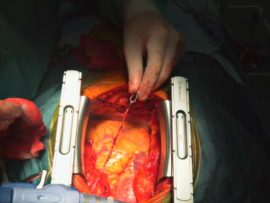Abstract Over the past decade, continuous-flow rotary pumps have dramatically improved survival for patients with advanced . Bleeding and thrombosis, however, continue to be the Achilles heel of (LVAD) therapy. There is..
Read MoreAbstract Objective: In order to assess the current status of temperature management during cardiopulmonary bypass (CPB) in China and, thereby, implement standardized management protocols, the authors carried out a national..
Read MoreAbstract The VentriFlo True Pulse Pump (Design Mentor, Inc., Pelham, NH, USA) is the first blood pump designed to mimic human arterial waveforms in a standard oxygenation circuit. Our aim was..
Read MoreAbstract Objectives: This study was undertaken to estimate the incidence and burden of cerebral microhemorrhage (CM) in patients with heart disease who underwent cardiopulmonary bypass (CPB), as detected on susceptibility-weighted..
Read MoreAbstract Purpose Cardiopulmonary bypass (CPB) induces a significant inflammatory response that may increase the risk for delirium. We hypothesized that exposure to CPB during coronary artery bypass grafting (CABG) surgery..
Read MoreAbstract During cardiac operations, weaning from cardiopulmonary bypass (CPB) may prove challenging as a result of superimposed acute right ventricular dysfunction in the setting of elevated pulmonary vascular resistance (PVR)...
Read MoreAbstract The present study is the premier clinical attempt to scrutinize the practicability of prophylactic fibrinogen infusion in patients undergoing heart transplantation (HT). A total of 67 consecutive patients who..
Read MoreAbstract Background Haem levels are associated with thrombosis in a variety of diseases, as well as being a contributing cause of thrombotic events in animal models. Materials and Methods We..
Read MoreAbstract Introduction: Bispectral index (BIS) and monitoring of end-tidal concentration may be associated with a reduction in the incidence of awareness during volatile-based general anaesthesia. An analogue of end-tidal concentration..
Read MoreAbstract Background: Modified ultrafiltration (MUF) can be performed in infants with ventricular septal defects (VSDs) after cardiopulmonary bypass (CPB) to reduce haemodilution and its potential adverse effects. High-flow MUF might..
Read MoreAbstract Heparin-induced thrombocytopenia type II (HIT) is a rare but potentially fatal antibody-mediated reaction to all forms of heparin (unfractionated heparin, low-molecular weight heparin, heparin flushes, and heparin-coated catheters), which..
Read MoreAbstract Waldenström’s macroglobulinemia (WM) manifests as hyperviscosity syndrome. Cryoglobulinemia, which may increase blood viscosity or induce thrombosis in association with decreased body temperature, can occur in combination with WM. We..
Read MoreAbstract Objectives: To describe donors after brain death with ongoing extracorporeal membrane oxygenation and to analyze the outcome of organs transplanted from these donors. Design: Retrospective analysis of the national..
Read MoreExtracorporeal life support (ECLS), commonly referred to as extracorporeal membrane oxygenation (ECMO), is a modified form of cardiopulmonary bypass. Venous blood is drained from the patient and advanced to a..
Read MoreAbstract Objectives To determine the optimal vancomycin dosing regimen to achieve empirical goal trough concentrations in pediatric patients with congenital heart disease and to examine the impact of cardiopulmonary bypass..
Read MoreAbstract Though historically the development of cardiovascular perfusion grew out of the need for cardiopulmonary bypass, the application of technologies of extracorporeal support has more recently expanded beyond the traditional..
Read MoreAbstract We present a case series of seven patients with suspected cold agglutinin antibodies, discovered after initiation of bypass. Laboratory analysis of blood samples intraoperatively determined the cause of the..
Read MoreAbstract Objective To determine the impact of different strategies on the incidence of cerebral embolic events during (CABG). Methods Between 2012 and 2015, 142 patients with low-grade (epiaortic ultrasound grade I/II) undergoing primary..
Read MoreAbstract Backgroud Unilateral and bilateral antegrade (ACP) are recognized methods of cerebral protection in . However, the adequacy of cerebral protection in aortic arch surgery with is controversial. In this study, we compared..
Read MoreAbstract The aim was to evaluate the efficacy and safety of volatile anaesthetic for postoperative sedation in adult cardiac surgery patients through a systematic review and meta-analysis. We retrieved randomized..
Read MoreAbstract OBJECTIVES: Information is lacking about long-term survival and quality of life (QOL) after treating patients on extracorporeal life support. METHODS: Outcome data were assessed by phone interviews, a QOL..
Read MoreAbstract Rationale Pneumonia remains the most common major infection after cardiac surgery despite numerous preventive measures. Objectives To prospectively examine the timing, pathogens, and risk factors, including modifiable management practices,..
Read MoreAbstract Objective There are few data on the role of in patients with end-stage heart failure supported by mechanical . The aim of our study was to investigate predictors for in patients with..
Read MoreAbstract Background Data are sparse on long-term mortality after coronary artery bypass graft (CABG) surgery. We examined short-term and long-term mortality of patients undergoing CABG surgery and a general population..
Read MoreAbstract Quality problem or issue The traditional variable life-adjusted display (VLAD) is a graphical display of the difference between expected and actual cumulative deaths. The VLAD assumes binary outcomes: death..
Read MoreAbstract At the time of writing this editorial, I have been in health care for exactly 45 years. These years have taken me through many challenging settings, including intensive cares,..
Read MoreAbstract Static cold storage is accompanied with a partial safe ischemic interval for donor hearts. In this current study, a machine perfusion system was built to provide a better preservation..
Read MoreThis report describes the case of a 63-year-old female patient, who was admitted to the Intensive Care Unit with the diagnosis of septic shock. [pdf-embedder url="https://perfusfind.com/wp-content/uploads/2021/03/caso-semana-cyto_compressed.pdf" title="caso semana cyto_compressed"]
Read MoreAbstract OBJECTIVES The aim of this study was to assess the safety and effectiveness of our selective antegrade brain perfusion (SABP) strategy, which is characterized by moderate hypothermic and low-pressure..
Read More













